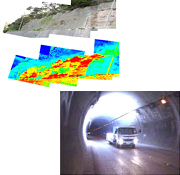Urban development
Planning to extend life of buildings
Long Life Plan Establishment Support

In recent years, as the social capital put in place during Japan’s high economic growth period ages rapidly, the approach has shifted from “response maintenance” to “preventative maintenance”, and there is a strong demand for extending the lifespans of facilities while at the same time decreasing the LCC (life cycle costs) of facilities. In particular, in commercial ports, which have a critical position as a hub of logistics and people, fishing ports, which serve as marine product supply infrastructures, and the shores protecting the social capital of the coastal lowlands, changes in function in response to societal changes and demands, and effective maintenance management, have become essential.
The on-site studies which form the base data upon which plans are established use the sea measurement and survey technologies we have mastered over the years, providing results in perfect accordance with these needs.
- We provide project establishment proposals for extending useful lifespans in order to reduce overall maintenance and management costs based on systematic LCC base data.
- We provide survey results for the establishment of maintenance and management plans and function maintenance plans, from the standpoints of “maintaining objectivity,” “improving efficiency,” and “record retention.”
-
In our facility condition surveys, we perform measurement and survey work in order to gain a safe, efficient, more accurate understanding of current conditions. We also offer the following quantitative surveys in accordance with the conditions and importance of specific facilities.
-We use digital images to assess concrete deformation, producing a history of records that are used for objective evaluation of deformation progress.
-We combine Multibeam Echo Sounders and 3D scanners in simultaneous 3D surveying of water and land, precisely and effectively capturing the shapes of facilities both under water and on land in the form of 3D data.
-Our underwater deterioration diagnosis equipment using acoustic video cameras provides underwater structure images which have been heretofore difficult to obtain.
-Retaining and managing inspection results as facility deterioration prediction base data is important, so we offer systematic data management tools.
Inspecting and Diagnosing Structures

Japan’s stock of social capital reached nearly 800 trillion yen at the end of the 20th century. However, there are concerns about a shortage of social capital sources, including new investments, due to the prolonged recession, reductions in the number of children per family, and the aging and shrinking of the population.
Because of this situation, Japanese society will be shifting from an era of building to an era of maintaining/managing and renewal. Kokusai Kogyo is developing and providing new technologies for diagnosing/inspecting structures that will provide support for an era of maintenance/management. Based on information backed by highly reliable diagnostic/inspection technologies, we suggest appropriate repair/reinforcement measures and develop rational plans and designs intended to reduce lifecycle cost and ensure safety.
- Leveraging the expertise in spatial information/digital image processing that we have accumulated as a major aerial survey service provider, we are developing new inspection/diagnostic technologies.
- For inspecting structures, we are providing a sprayed-on slope face and bridge inspection system that uses thermal infrared video imaging, and a tunnel inspection technology that uses high-definition imaging. Because these systems are able not only to perform quantitative diagnosis and evaluation, but also to manage the inspection data as digital information, they can track changes that occur over time and provide the base data for subsequent inspections. A viewer function is also provided to allow the user to quickly search and display inspection results.
- We can inspect bridges in sync with the creation/updating of road registers by local municipalities, collect the base data that can be used for creating plans for repairing or extending the life of structures (bridges), and help them update their road management system databases.
- By introducing the latest repair/reinforcement technologies, we create optimum plans/designs in terms of both cost and benefit.

